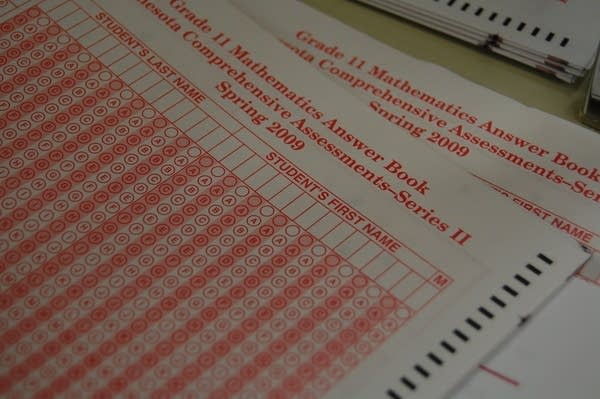Some improvement, but Minnesota test scores mostly flat
Go Deeper.
Create an account or log in to save stories.
Like this?
Thanks for liking this story! We have added it to a list of your favorite stories.

More than 500,000 Minnesota students who took the MCA-II standardized tests this spring will soon find out how they did.
The state is releasing those scores today, which schools will soon forward to students.
And while there were some improvements in some areas, the results show this year's scores stayed mostly steady, when compared to last year.
Test scores come in two parts; how the kids did and how the schools did. Today's numbers have more to do with how the kids did.
Turn Up Your Support
MPR News helps you turn down the noise and build shared understanding. Turn up your support for this public resource and keep trusted journalism accessible to all.
We now know, for example, that 82 percent of the state's third graders were proficient in math and 78 percent were proficient in reading. As grade numbers increase, proficiency falls. So by eighth grade, just 66 percent of students were proficient in reading and 60 percent were in math.
"What we're pleased about is we've made really good progress from 2006-2009 with all students."
The ratings for how schools did - a term called Annual Yearly Progress - comes out later this summer.
"Sixty percent will never be good enough," said Chas Anderson, Minnesota's Deputy Education Commissioner. "It won't be good enough until we hit 100 percent proficiency, and those are our benchmarks and that's what we want to reach.
"What we're pleased about is we've made really good progress from 2006-2009 with all students. We feel we're on the right track as it relates to math."
While that 100 percent sounds and feels good, it's also the law. All students in all grades must be proficient by 2014.
But while Minnesota has a ways to go to get there, Anderson said there are a lot of reasons to be pleased. For one, she notes that every state sets different standards, so a state that claims to have 90 percent proficiency might only be asking less of its students.
Anderson said Minnesota's aim is tough standards, even if that means lowers numbers.
"Because we actually know in the end, even though our numbers are lower, our students will be better prepared to go to work [and] better prepared to go onto college than other states," Anderson said.
Most of this year's numbers are only one or two percentage points above or below last year's marks - with one exception - 11th-grade math. Forty-two percent of 11th graders were proficient in math this year, which is a gain of 8 percentage points over last year.
The state ties that gain to the fact that this was the first year high school juniors also had to take the GRAD test. At the time of the test, students were told they'd have to pass it to graduate, so the stakes were high.
The law has since changed, though, which is why Anderson thinks numbers for 11th-grade math will fall back next year.
The very release of scores like these always rekindles the debate over their usefulness.
"I look at the MCAs as more of an autopsy as opposed to a well-baby exam," said Pat Schmidt, principal of Hopkins North Junior High in suburban Minnetonka. "It's data that comes dead on arrival, months after we're working with the child. Test them in the spring, move them onto the next grade level. That data has a little less reliability for me."
The state says getting data in the summer will help teachers. By looking at Johnny's third-grade scores, for example, his fourth-grade teacher can see where he needs help.
But Schmidt wonders why the tests couldn't be earlier in the year, so the third-grade teacher would also have time to make changes.
On that point, this might be Schmidt's year. Congress will debate No Child Left Behind this fall. However, there's no way to know at this point what changes will be made.
If nothing else, the scores act as a reminder that there's still room for improvement. Meria Carstarphen spent her last day as St. Paul's superintendent yesterday pouring over the new numbers. Numbers like 22, the percentage of 11th-graders in St. Paul proficient in math.
Carstarphen, who's leaving to head the Austin, Texas, school district, said there are plenty of reasons why that 22 is such a hard number to move. But at the end of the day, the excuses don't matter, she said.
"Federal laws or state statues should not be what drives us in teaching a kid to read," Carstarphen said. "So long as the majority of our children - and I'd say that's a low standard - but so long as a majority of our students aren't proficient, we just need to keep working. We still haven't done our job."
Now that students will soon know how they did, schools are next. That Annual Yearly Progress list - the list where schools are actually noted as "failing" - comes out later.
Last year, about half of Minnesota's schools were not meeting AYP. Even though scores improved slightly in most cases this year, state officials say they didn't improve at the rate needed to keep up with AYP demands and that's why the state expects even more schools to make that dreaded list, come August.





